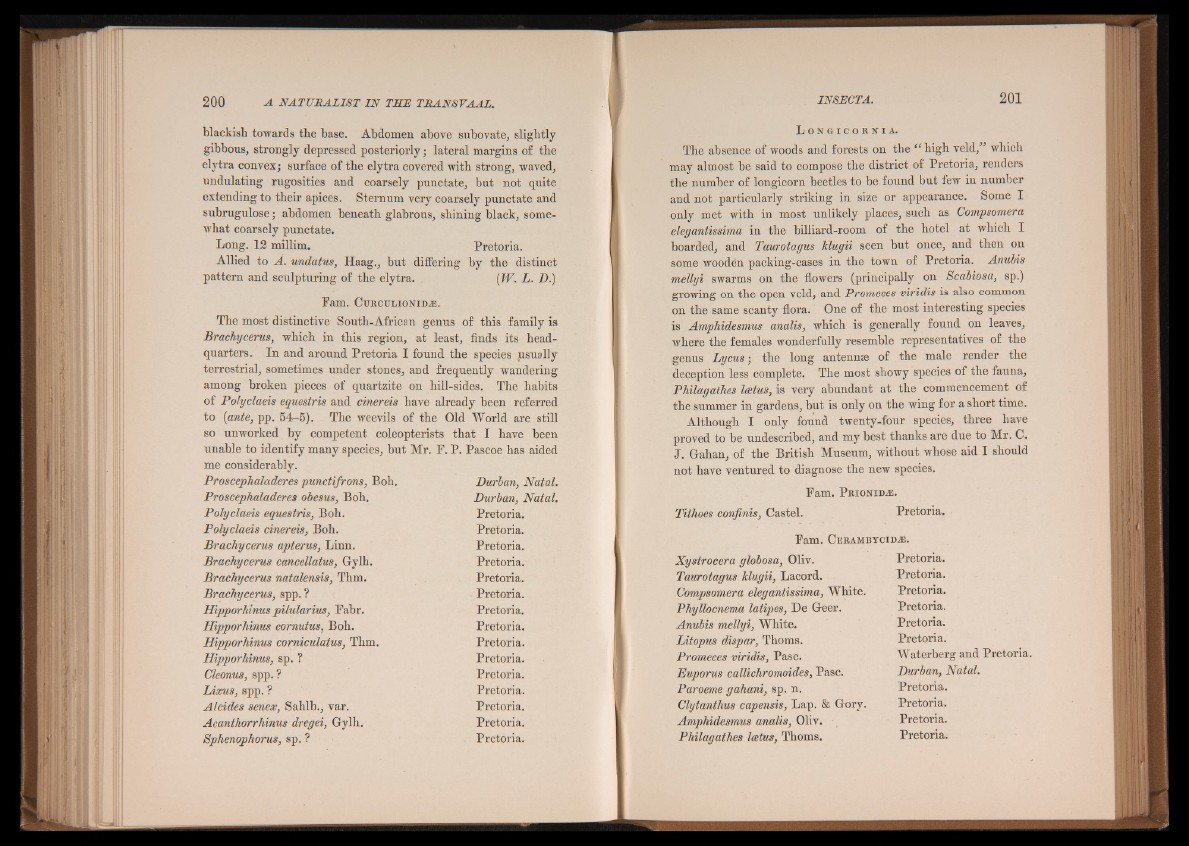
blackish towards the base. Abdomen above subovate, slightly
gibbous, strongly depressed posteriorly; lateral margins of the
elytra convex; surface of the elytra covered with strong, waved,
undulating rugosities and coarsely punctate, but not quite
extending to their apices. Sternum very coarsely punctate and
subrugulose; abdomen beneath glabrous, shining black, somewhat
coarsely punctate.
Long. 12 millim. Pretoria.
Allied to A. undatus, Haag., but differing by the distinct
pattern and sculpturing of the elytra. (W. L. D.)
F a m . CuRCULioNiDiE.
The most distinctive South-African genus of this family is
Brachycerus, which in this region, at least, finds its headquarters.
In and around Pretoria I found the species ^usually
terrestrial, sometimes under stones, and frequently wandering
among broken pieces of quartzite on hill-sides. The habits
of Polyclaeis equestris and ciñereis have already been referred
to {ante, pp. 54-5). The weevils of the Old World are still
so unworked by competent coleopterists that I have been
unable to identify many species, but Mr. F. P. Pascoe has aided
me considerably.
Proscephaladeres punctifrons, Boh. Durian, Natal.
Proscephaladeres obesus, Boh. Durban, Natal.
Polyclaeis equestris, Boh. Pretoria.
Polyclaeis ciñereis, Boh. Pretoria.
Brachycerus apterus, Linn. Pretoria.
Brachycerus cancellatus, Gylh. Pretoria.
Brachycerus natalensis, Thm. Pretoria.
Brachycerus, spp. ? Pretoria.
Hipporhinus pilularius, Fabr. Pretoria.
Hipporhinus cornutus, Boh. Pretoria.
Hipporhinus corniculatus, Thm. Pretoria.
Hipporhinus, sp. ? Pretoria.
Cleonus, spp. ? Pretoria.
Lixus, spp. ? Pretoria.
A/cides senex, Sahib., var. Pretoria.
Acanthorrhinus dregei, Gylh. Pretoria.
Sphenophorus, sp. ? Pretoria.
L o n g i c o r n i a .
The absence of woods and forests on the “ high veld,” which
may almost be said to compose the district of Pretoria, renders
the number of longicorn beetles to be found but few in number
and not particularly striking in size or appearance. Some I
only met with in most unlikely places, such as Compsomera
elegantissima in the billiard-room of the hotel at which I
boarded, and Taurotagus Jclugii seen but once, and then on
some wooden packing-cases in the town of Pretoria. Anubis
mellyi swarms on the flowers (principally on Scabiosa, sp.)
growing on the open veld, and Promeces viridis is also common
on the same scanty flora. One of the most interesting species
is Amphidesmus analis, which is generally found on leaves,
where the females wonderfully resemble representatives of the
genus Lycus; the long antennae of the male render the
deception less complete. The most showy species of the fauna,
Philagathes Icetus, is very abundant at the commencement of
the summer in gardens, but is only on the wing for a short time.
Although I only found twenty-four species, three have
proved to be undescribed, and my best thanks are due to Mr. C.
J. Gahan, of the British Museum, without whose aid I should
not have ventured to diagnose the new species.
Fam. P r io n id a <:.
Tithoes confinis, Castel. Pretoria.
Fam. CERAMBYCIU-ffi.
Xystrocera globosa, Oliv. Pretoria.
Taurotagus Jclugii, Lacord. Pretoria.
Compsomera elegantissima, White. Pretoria.
Phyllocnema latipes, De Geer. Pretoria.
Anubis mellyi, White. Pretoria.
Litopus dispar, Thoms. Pretoria.
Promeces viridis, Pasc. Waterberg and Pretoria.
Euporus callichromoides, Pasc. Durban, Natal.
Paroeme gahani, sp. n. Pretoria.
Clytanthus capensis, Lap. & Gory. Pretoria.
Amphidesmus analis, Oliv. Pretoria.
Philr/nrifhps hpfns. Thoms. Pretoria.